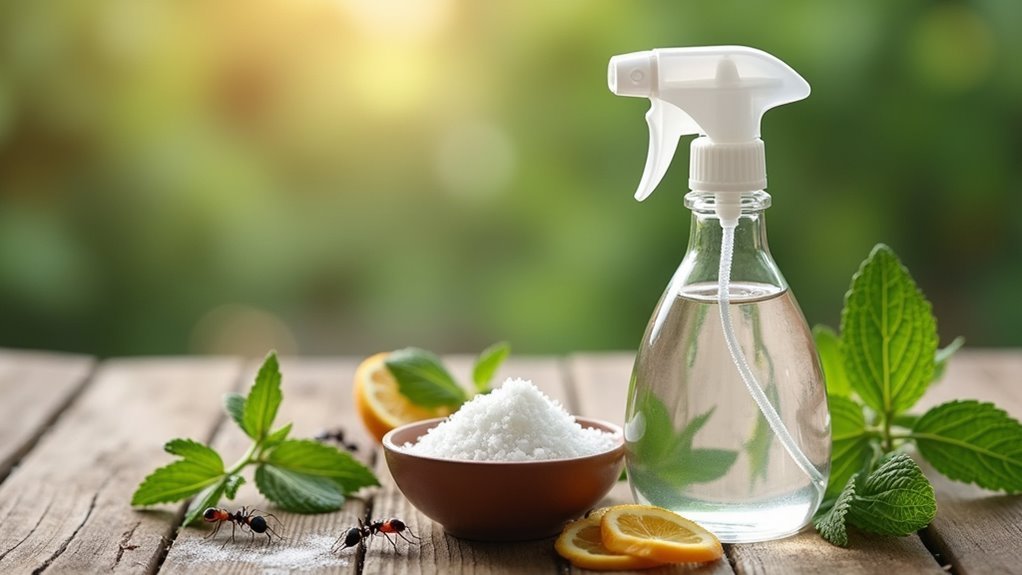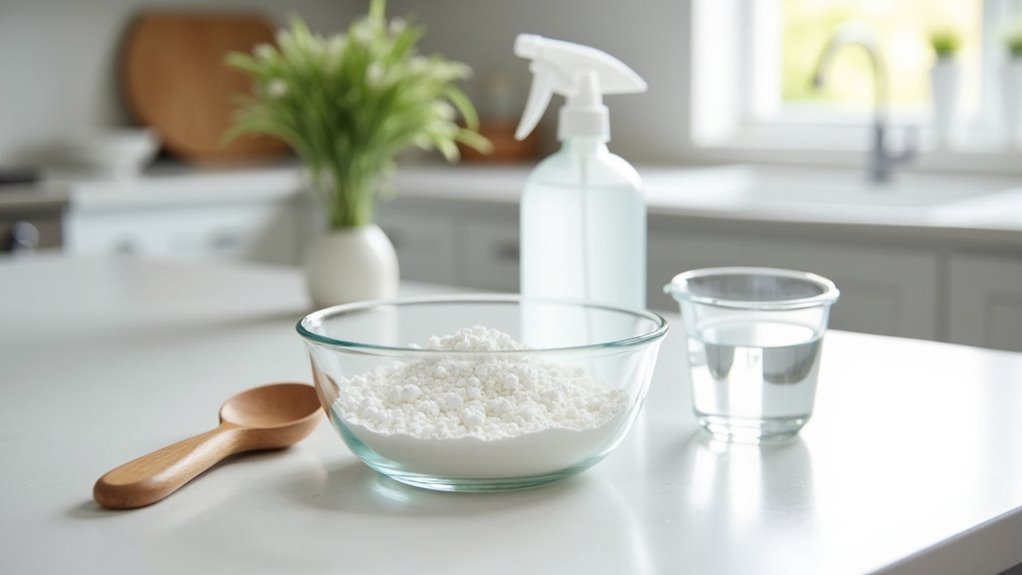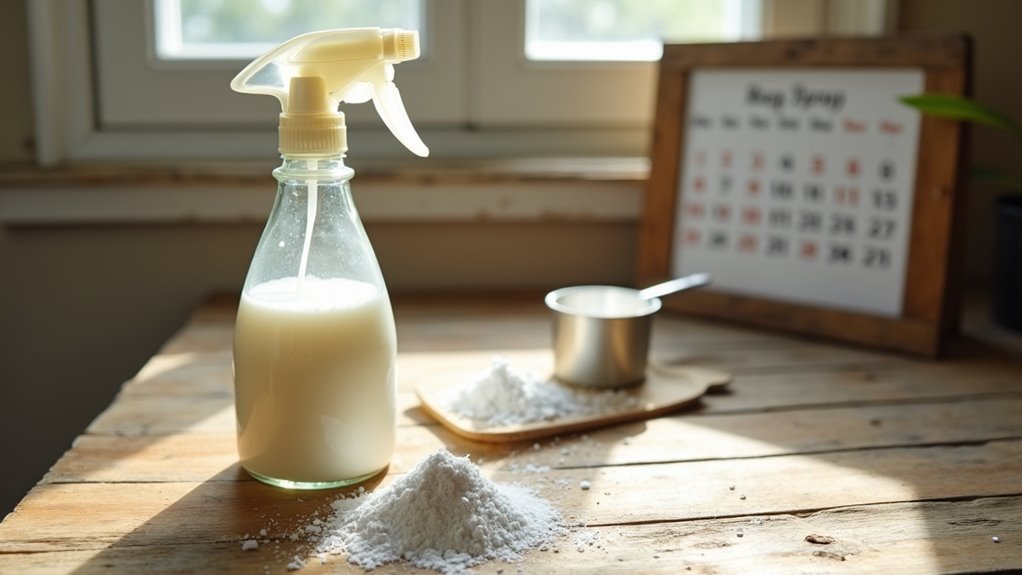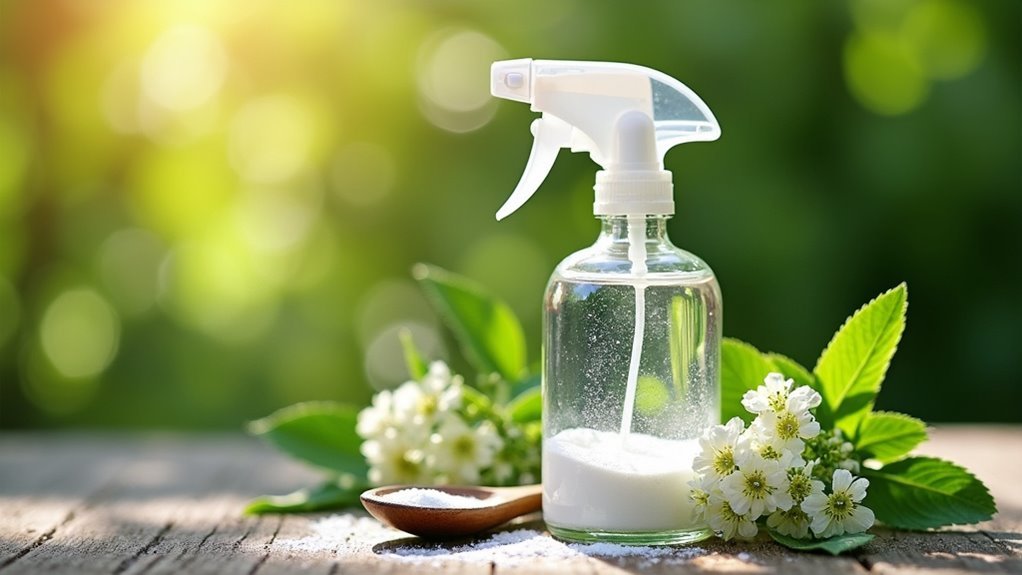You can make an effective boric acid bug spray by mixing one cup of hot water, two tablespoons of boric acid, and two cups of sugar in a clean spray bottle. Stir the solution thoroughly until it’s completely dissolved and clear, then let it cool before use. Always wear gloves and a dust mask when handling boric acid, and keep the mixture away from children, pets, and food surfaces. This slow-acting formula will eliminate roaches and ants while spreading throughout their colonies for extensive pest control that lasts months.
Understanding How Boric Acid Works Against Common Household Pests

When you’re dealing with stubborn household pests, boric acid works as a multi-pronged weapon that attacks insects in several devastating ways.
First, it acts as a stomach poison, disrupting metabolism and causing starvation when ingested. The microscopic crystals also create abrasions on insect exoskeletons, leading to fatal dehydration. At higher concentrations, boric acid affects the nervous system, making it even more lethal for pest control.
Boric acid delivers a triple threat: disrupting insect metabolism, abrading exoskeletons for dehydration, and attacking nervous systems at higher doses.
What makes this compound particularly effective is its slow-acting nature. Contaminated roaches spread the poison throughout their colonies through grooming and cannibalism.
Unlike other treatments, most household pests haven’t developed resistance to boric acid, making it a reliable long-term solution to manage pests effectively.
Essential Ingredients and Supplies for Your Homemade Bug Spray
Now that you understand boric acid’s lethal effects on household pests, you’ll need the right ingredients and supplies to create your own bug spray. You’ll need one cup of water, two tablespoons of boric acid, and two cups of sugar as a sweet attractant. Hot water works best to dissolve ingredients completely when you mix boric acid with sugar.
Essential supplies include a clean spray bottle for storage and application, plus safety gear. Always wear gloves and a dust mask when handling boric acid powder to prevent skin contact and inhalation. Label your spray bottle clearly to avoid accidental contact with food sources or areas accessible to children and pets. This homemade solution costs less than hiring a pest control company.
Step-by-Step Mixing Instructions for Maximum Effectiveness

You’ll achieve the best results by following precise mixing ratios that balance effectiveness with safety.
Start with the correct proportions of boric acid to water, then take essential precautions to protect yourself and others during preparation.
These careful steps guarantee your homemade spray works effectively while minimizing risks to people and pets in your home.
Proper Mixing Ratios
To enhance attractant properties, incorporate 2 cups of sugar into your mixture.
The hot water helps dissolve the boric acid powder completely, creating a uniform consistency that won’t clog your spray bottle. Stir thoroughly until all particles disappear and the solution becomes clear.
Once you’ve achieved proper dissolution, allow the mixture to cool before transferring it to a clearly labeled airtight container.
This storage method preserves potency and prevents contamination, ensuring your spray remains effective for future applications.
Application Safety Precautions
Before you begin mixing your boric acid spray, gather essential safety equipment including nitrile gloves, a dust mask, and safety glasses to protect yourself from direct contact with the powder.
These application safety precautions are vital since boric acid dust can irritate your skin and respiratory system. Always wear protective gloves throughout the entire process and avoid inhaling particles by keeping your mask secure.
Mix your solution in a well-ventilated area, preferably outdoors, to prevent dust accumulation indoors. Once prepared, store the spray in a labeled airtight container positioned safely away from humans and pets.
Apply only in hidden areas like cracks and crevices where accidental contact won’t occur.
Target Areas and Proper Application Techniques
You’ll achieve ideal results by targeting specific indoor zones where pests congregate and applying your boric acid spray with proper technique.
Focus on high-moisture areas like kitchens and bathrooms, particularly around sinks, drains, and behind appliances where bugs thrive.
Master the right spray coverage methods while maintaining safety protocols to protect your family and pets during application.
Prime Indoor Application Zones
Several key areas in your home provide ideal targets for boric acid spray application, with kitchens and bathrooms topping the list due to their high-moisture environments that attract roaches and other pests.
Focus on cracks and crevices around these high-moisture areas, especially behind appliances, under sinks, and near toilets where insects commonly hide. These application zones offer strategic advantages—they’re less visible locations that increase pest contact while reducing human exposure.
Apply the spray using a fine mist to create even coating on surfaces, ensuring better adherence and enhanced pest control effectiveness.
You’ll need to monitor and reapply the treatment regularly, particularly after cleaning sessions or high-traffic periods, to maintain the boric acid’s potency in these critical zones.
Spray Coverage Techniques
Effective spray coverage depends on targeting the right areas with proper application methods to maximize pest elimination.
You’ll achieve better results by focusing on specific application areas where insects naturally congregate and travel.
Follow these essential spray coverage techniques:
- Target entry points like door frames, window sills, and wall cracks where bugs infiltrate your home.
- Concentrate on damp areas including basements and bathrooms where cockroaches and silverfish thrive.
- Focus on hiding places behind appliances, under sinks, and along baseboards where pests travel.
- Apply fine mist coverage evenly across surfaces, avoiding puddles that reduce effectiveness.
You’ll need to regularly reapply your boric acid spray, especially after cleaning or rain.
This consistent approach works better than boric acid dust for reaching vertical surfaces and tight spaces.
Safety During Application
When handling boric acid spray, protecting yourself and others becomes just as important as eliminating pests.
Always wear gloves and a mask during safety during application to avoid skin contact and prevent inhaling part boric acid particles that can irritate your respiratory system.
Keep boric acid away from food, drinks, and areas where children and pets can access during application.
Apply the spray in thin, even layers rather than thick piles to minimize exposure while maintaining effectiveness.
Focus on hidden areas like cracks, crevices, and behind appliances where bugs typically hide.
After spraying, temporarily seal off treated areas if possible and allow surfaces to dry completely before normal use resumes.
Safety Precautions When Using Boric Acid Spray Indoors
While boric acid spray offers an effective solution for indoor pest control, you’ll need to follow essential safety measures to protect yourself and your household.
Boric acid provides powerful pest control, but proper safety precautions are absolutely essential to protect your family from potential harm.
These safety precautions guarantee effective pest control without compromising your family’s well-being:
- Wear protective gear – Always use gloves and a mask during application to prevent skin contact and inhalation of dust particles.
- Keep away from children and pets – Apply boric acid only in inaccessible areas to prevent accidental ingestion or exposure.
- Avoid food surfaces – Never spray on utensils, cooking areas, or food preparation zones to prevent contamination.
- Guarantee proper ventilation – Thoroughly ventilate treated areas after application to dissipate fumes and reduce inhalation risks.
Store boric acid in its original, labeled container away from family members.
Maintenance Schedule and When to Reapply Treatment

After implementing proper safety measures, maintaining your boric acid treatment requires a consistent schedule to keep pests at bay.
You’ll need to reapply treatment every 2-3 months for ideal pest control effectiveness. However, don’t wait for the scheduled time if you notice significant pest activity – reapply immediately.
Create a maintenance schedule that includes weekly inspections of treated areas. Look for dead insects and monitor whether you’re seeing fewer pests, as these indicators help determine if your treatment’s working effectively.
Clean treated surfaces regularly to prevent dust buildup that reduces boric acid’s effectiveness.
If you spot increased pest activity during your weekly checks, it’s time to reapply the treatment regardless of your schedule. This proactive approach guarantees continuous protection against unwanted insects.
Frequently Asked Questions
How to Make a Spray With Boric Acid?
You’ll mix 1 cup hot water with 2 tablespoons boric acid powder, stirring until dissolved. Add 2 cups sugar for pest attraction, transfer to spray bottle, and shake well before each application.
What’s the Best Thing to Mix With Boric Acid?
You’ll get best results mixing boric acid with sugar using a 1:3 ratio. Sugar attracts insects while boric acid kills them. Alternatively, combine it with honey or Karo syrup for stickier, more effective bait.
What Is the Best Homemade Bug Spray?
You’ll find the most effective homemade bug spray combines two cups water, two tablespoons boric acid, and two cups sugar. Heat the mixture until sticky, then place it near insect activity areas.
Can You Put Boric Acid in a Spray Bottle?
You can put boric acid in a spray bottle by mixing one tablespoon per cup of water. Label it clearly and store safely away from children and pets for effective pest control.
In Summary
You’ve now got everything you need to tackle those pesky bugs with your homemade boric acid spray. Remember to follow safety guidelines, especially around pets and children, and stick to your reapplication schedule for best results. Target cracks, crevices, and entry points where insects hide. With consistent use and proper application techniques, you’ll notice fewer unwanted visitors in your home. Keep monitoring treated areas and adjust your approach as needed.





Leave a Reply